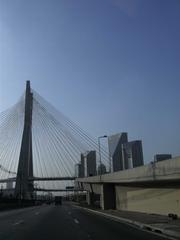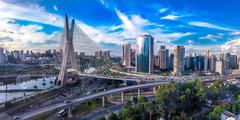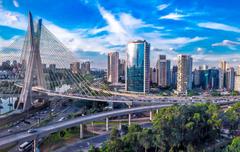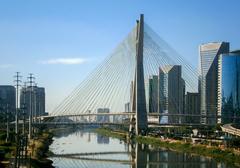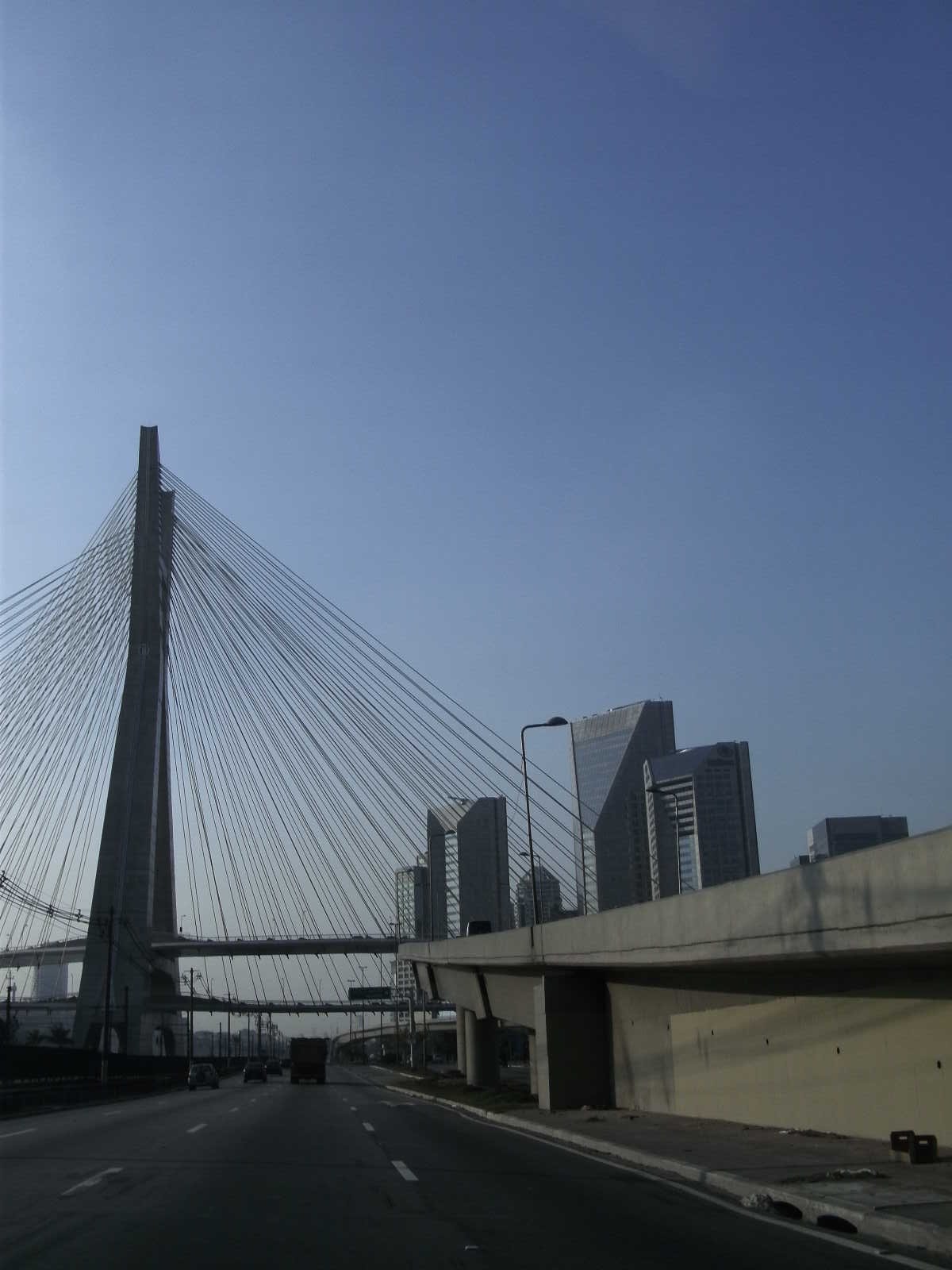
Octavio Frias de Oliveira Bridge: Visiting Hours, Tickets, and Travel Guide for São Paulo’s Modern Marvel
Date: 14/06/2025
Introduction: São Paulo’s Architectural Landmark
The Octávio Frias de Oliveira Bridge—widely known as “Ponte Estaiada”—is a defining symbol of São Paulo’s contemporary skyline. Completed in 2008, this innovative cable-stayed bridge not only serves as a vital link between the Brooklin and Morumbi districts but also stands as a testament to the city’s rapid urban transformation and architectural ambition. With its singular X-shaped concrete tower supporting two elegantly curved decks, the bridge exemplifies both mathematical harmony and urban artistry, drawing inspiration from da Vinci’s Vitruvian Man (Midasoft; Failed Architecture). Whether you are an architecture enthusiast, photographer, or simply a curious traveler, the Octávio Frias de Oliveira Bridge promises a unique perspective on São Paulo’s dynamic development.
Table of Contents
- Introduction
- Historical Background and Cultural Impact
- Design and Engineering
- Visiting Information
- Nearby Attractions
- Special Events and Lighting
- Photography Tips
- Visitor FAQs
- Conclusion
- Further Reading and Resources
Historical Background and Cultural Impact
Constructed as part of the Água Espraiada Urban Operation, the bridge was envisioned as a catalyst for the revitalization of the Pinheiros River area, transforming it from a neglected riverbank to a thriving business hub. Named in honor of Octávio Frias de Oliveira, a notable journalist and founder of Grupo Folha, the bridge has become a contemporary icon representing São Paulo’s aspirations to global city status (Failed Architecture).
Its presence has spurred significant development in the surrounding districts, attracting multinational corporations, upscale hotels, and luxury residences. The bridge also frequently serves as a backdrop for major city events, from New Year’s Eve celebrations to marathons and concerts, embedding itself in São Paulo’s cultural calendar.
Design and Engineering
Unique Architecture
The Octávio Frias de Oliveira Bridge is the only cable-stayed bridge in the world with two curved decks supported by a single X-shaped pylon. Rising 138 meters above the Pinheiros River, the decks cross each other at different heights—12 and 24 meters—creating a distinctive, interlaced silhouette (Midasoft; Wikipedia). The structure is stabilized by 144 cable stays arranged in an elegant fan pattern, further enhancing its visual impact, especially when illuminated at night (Art Facts).
Engineering Significance
With a total length of 1,600 meters and a main span of 290 meters, the bridge was engineered to handle heavy urban traffic while becoming an urban landmark. Its advanced LED lighting system allows for vibrant displays during city celebrations, holidays, and awareness campaigns, reinforcing its role as a civic symbol (Trek Zone).
Visiting Information
Hours and Access
- Vehicular Traffic: The bridge is open to vehicles 24/7, serving as a key artery in São Paulo’s road network.
- Pedestrian/Bike Access: There are no pedestrian walkways or bicycle lanes on the bridge itself. Visitors should use the surrounding parks and public spaces for viewing and photography.
- Top Viewing Spots: The most popular viewpoints are along the Marginal Pinheiros riverbanks and in nearby parks such as Parque do Povo.
Tickets and Guided Tours
- No Entry Fees: There is no ticket required to visit or photograph the bridge from surrounding public areas.
- Guided Tours: Some São Paulo city tours and architecture-themed excursions include stops at the bridge’s best viewing points. Booking in advance is suggested for guided experiences.
Getting There
- Public Transit: The bridge is accessible via São Paulo Metro Line 5 (Lilac), with stations such as Brooklin and Morumbi nearby. Buses and ride-share options are plentiful.
- By Car: Parking is available at local malls and in the Brooklin business district, though public transit is often faster due to city traffic.
Nearby Attractions
Enhance your visit by exploring nearby points of interest:
- Parque do Povo: A modern urban park ideal for relaxation, jogging, and panoramic views of the bridge.
- D&D Shopping and Shopping Iguatemi: Upscale shopping centers with dining and entertainment options.
- Vivo Theatre: Contemporary performances and films close to the bridge.
- Instituto Bardi (Glass House): Historic modernist architecture by Lina Bo Bardi.
- Fundação Maria Luisa e Oscar Americano: A museum and cultural center in lush gardens.
Special Events and Lighting
The bridge’s LED system creates dazzling light displays for special occasions, holidays, and public campaigns, including New Year’s Eve, city festivals, and social awareness events. These nighttime illuminations make the bridge a favorite for photographers and locals alike (Trek Zone).
Photography Tips
- Golden Hour: Visit at sunrise or sunset for the warmest light and dramatic effects.
- Night Shots: Use a tripod to capture the bridge’s vibrant LED displays.
- Best Angles: Seek out riverside parks and pedestrian bridges for unobstructed views.
- Special Events: Check the city’s event calendar for special lighting.
Visitor FAQs
Q: Can I walk or bike across the Octávio Frias de Oliveira Bridge?
A: No, the bridge is strictly for vehicles. Pedestrian and bicycle access is not permitted.
Q: Are there entrance fees or tickets required?
A: No, the bridge can be freely viewed from public areas; no tickets are necessary.
Q: Is the bridge accessible for people with disabilities?
A: While the bridge itself is not pedestrian-accessible, nearby parks like Parque do Povo offer accessible paths and facilities.
Q: When is the best time to visit for photography?
A: Sunset and nighttime, especially during special lighting events, provide the most striking visuals.
Q: Are guided tours available?
A: Yes, several city tours include stops at the bridge’s best viewpoints.
Conclusion
The Octávio Frias de Oliveira Bridge stands as a powerful emblem of São Paulo’s drive for innovation, connectivity, and cultural vibrancy. While pedestrian crossing on the bridge is not possible, its presence enhances the city’s skyline, offering memorable viewing and photography opportunities from nearby parks and public spaces. The surrounding district’s parks, shopping centers, and cultural venues make it easy to combine your bridge visit with a broader exploration of São Paulo’s modern attractions.
Whether you are an architecture aficionado, a history lover, or a casual explorer, the bridge is a must-see destination. For the best experience, plan your visit during special lighting displays or city events, and utilize nearby accessible parks for the best views.
For real-time updates, personalized travel tips, and to discover more of São Paulo’s top destinations, download the Audiala app and follow São Paulo’s official tourism channels.
Additional Resources
- Failed Architecture
- Midasoft
- Trek Zone
- Wikipedia
- Structurae
- ArchDaily
- São Paulo Official Tourism Website
- GetYourGuide – Local Guided Tours
Image 1: The Octávio Frias de Oliveira Bridge illuminated at night, showcasing its X-shaped tower and vibrant LED lighting.
Alt text: Night view of Octávio Frias de Oliveira Bridge in São Paulo with colorful LED lights illuminating the cables and tower.
Image 2: Panoramic daytime photo of the bridge’s double curved decks crossing over the Pinheiros River.
Alt text: Daytime panoramic view of the Octávio Frias de Oliveira Bridge showing its unique double curved decks and X-shaped tower.
